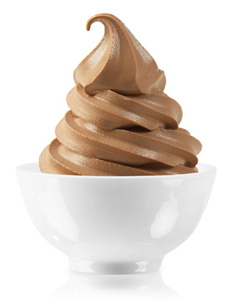|
Some 35 years ago, TCBY, The Country’s Best Yogurt, launched Fro-Yo: a soft serve, ice cream-style frozen yogurt that tasted more like soft serve ice cream. It was targeted to the many people who didn’t like the tartness of the original frozen yogurt products.*
*The first frozen yogurt, soft serve Frogurt, was introduced in New England in the 1970s by dairy company H. P. Hood. In 1978, Boston ice cream chain Brigham’s introduced the first packaged frozen yogurt, called Humphreez Yogart. Around this same time, Dannon introduced another packaged frozen yogurt product called Danny.
As everything old is new again, Pinkberry and Red Mango have led the renaissance of tart frozen yogurt.
The “newcomers” are advertising their frozen yogurt as probiotic and a good source of calcium, which is to say, healthier frozen yogurt.
So TCBY did what any company would do: It reformulated most of its Fro-Yo yogurt flavors to have a healthier profile.
|
|

Super Fro-Yo is super enhanced with
nutrition. Photo courtesy TCBY. |
New Super Fro-Yo is lowfat (below 2% fat). To keep the rich, creamy texture while lowering the fat, the yogurt now includes fiber, something that’s good for us.
Super Fro-Yo is also higher in protein, vitamins A and D and calcium, and it includes seven types of probiotic bacteria. Plus, the fiber in Super Fro-Yo also serves as a “prebiotic,” or food for the healthful probiotic bacteria in the yogurt. Prebiotics increase the number of live and active cultures—a minimum of 20 billion at the point of manufacture. (Learn more about prebiotics and probiotics.)
A four-ounce serving of Super Fro-Yo has fewer than 120 calories, at least 10% of the recommended daily value (DV) of vitamin A and 20% of the recommended DV of vitamin D. Even though fro-yo is made from milk/yogurt, each serving has less than 1 gram of saturated fat. In addition, each serving provides 3 grams of fiber and 4 grams of protein.
Traditional flavors include Cake Batter, Cheesecake, Chocolate, Fat-Free Dutch Chocolate, Golden Vanilla, Old-Fashioned Vanilla, Strawberry and White Chocolate Mousse. The chain will continue to carry the regular versions of TCBY yogurt in popular flavors that can’t meet Super Fro-Yo standards, such as the higher-calorie Peanut Butter.
The chain will continue to carry no sugar-added, nonfat yogurt and dairy-free sorbets.
Super Fro-Yo is now available at TCBY’s 440 domestic locations. Find a TCBY store near you.
|







